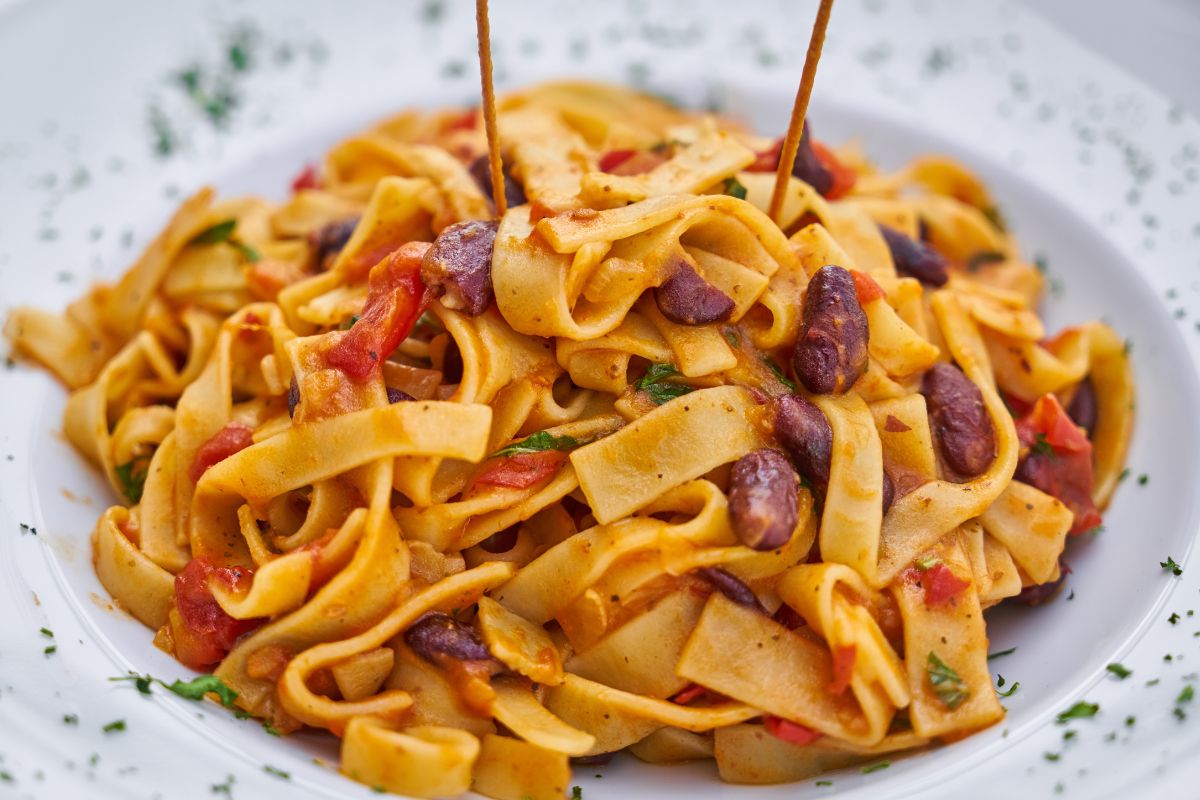How to Make Authentic Italian Pasta at Home

Making your own pasta starts with simple ingredients: finely milled Italian “00” flour and fresh eggs. (Many Italians still weigh their eggs for precision.) You’ll also need a pasta machine or rolling pin to roll out the dough, and plenty of semolina or flour to dust surfaces so the pasta doesn’t stick. Begin by making a mound of flour on your work surface and creating a well in the center. Crack the eggs and beat them with a fork, gradually incorporating the flour until a rough dough forms. Knead this dough by hand (or in a mixer) for about 5–7 minutes until it becomes smooth and elastic. Wrap the dough in plastic and let it rest for at least 30 minutes at room temperature so the gluten relaxes. This resting step is crucial for tender pasta.
With the dough rested, cut it into portions and roll each one into a thin sheet. Use a pasta machine (or a rolling pin) and work through progressively thinner settings, dusting with semolina flour as you go. The sheet is ready when it’s slightly translucent and your hand can be seen through it. Fold or drape the sheet and trim its edges if needed. Then pass it through the cutter attachment (or a sharp knife) to make noodles. You can make long ribbons like fettuccine/tagliatelle or wide strips like pappardelle. For stuffed pasta (ravioli), you’d keep the sheet whole and fill it. After cutting, it helps to let the pasta air-dry briefly (5–15 minutes) – for example, by hanging on a rack or draping over a chair. This “semi-dry” stage gives the pasta strands a firmer texture and prevents sticking.
Once cut, arrange the pasta on a floured tray or form it into loose nests. If you’re not cooking immediately, store it well-covered: leave it at room temperature if you’ll cook it within 1–2 hours, or refrigerate up to about 12 hours. For longer storage, let the pasta dry out for 15–20 minutes on a tray and then freeze it in portioned bags; it will keep about a month and can be cooked from frozen.
Pasta Shapes & Sauce Pairings
Italian pasta comes in hundreds of shapes, each traditionally paired with certain sauces. For example, tagliatelle and fettuccine are flat ribbon pastas (about ¼-inch wide) from the north. They are perfect for rich, slow-cooked sauces. In fact, the Bolognese meat ragù was made to cling to egg tagliatelle. Wide ribbons also carry creamy or truffle sauces well.
Ravioli are square or round pasta pillows filled with cheese, meat, or vegetables. Because ravioli are already rich, they usually get a light sauce – a simple butter-and-sage drizzle, fresh tomato sauce, or a mild cream sauce. “Light, cheesy ravioli pairs with a rich, meaty sauce, while meat-filled ravioli works better with something creamy or mild”.
Orecchiette (“little ears”) are a small cup-shaped pasta from Puglia. They are often served with hearty vegetable sauces – for example, sautéed turnip greens (cime di rapa) with garlic and anchovies, or broccoli-rabe pesto. The cupped shape catches bits of sauce and greens. In general, southern Italian pastas (like orecchiette) go with tomato sauces, olive oil dressings, and vegetable- or seafood-based sauces, whereas north-central pastas (like tagliatelle, fettuccine, and gnocchi) pair with butter, cream or meat ragùs.
Recipes for Classic Italian Pastas
Spaghetti alla Carbonara
Origins: A beloved Roman pasta dating back at least to the mid-20th century, Carbonara is famously simple. Despite modern confusion, authentic Carbonara uses no cream or garlic – just eggs, cheese, cured pork, and pepperl.
Ingredients: Spaghetti (or other long pasta), guanciale (cured pork jowl; pancetta is a common substitute), egg yolks (often whole eggs plus extra yolks), grated Pecorino Romano cheese, and freshly ground black pepper.
Preparation: Cook the spaghetti al dente in well-salted water. Meanwhile, sauté the guanciale in a pan over medium-low heat until its fat renders and the meat is crisp (about 5–8 minutes). Remove the guanciale (draining any excess fat) and set it aside. In a bowl, whisk together the eggs, most of the Pecorino cheese, and plenty of pepper.
Drain the pasta, reserving a cup of its cooking water. Off the heat (to avoid scrambling), toss the hot pasta with a little guanciale fat, then stir in the egg-cheese mixture. The heat of the pasta plus a splash of pasta water will gently cook the eggs into a silky sauce. Add most of the crunchy guanciale back in and toss until every strand is coated. Serve immediately, topped with extra guanciale, Pecorino, and cracked pepper. The result is creamy without cream – a true spaghetti alla carbonara.
Tagliatelle al Ragù (Bolognese)
Origins: Ragù alla Bolognese is a hearty meat-and-tomato sauce from Bologna, traditionally served with fresh egg tagliatelle. (Legend says it dates to the 16th century, and Italy’s culinary academy codified an “official” ragù recipe in 1982.)
Ingredients: The classic ragù uses ground beef (and/or pork), finely chopped onion, carrot and celery (soffritto), pancetta or bacon, wine, milk, tomato purée or passata, and a splash of broth.
Preparation: In a heavy saucepan, heat olive oil and sauté diced pancetta until it starts to brown. Add the minced carrot, celery and onion and cook gently until soft. Increase the heat, add the ground meat, and brown it thoroughly. Pour in half a cup of wine and let it evaporate. Then stir in the tomato purée, a little milk, and enough beef broth to just cover the meat. Simmer the sauce very slowly (ideally 2–3 hours), adding more broth as needed to keep it saucy. The long cooking time tenderizes the meat and blends the flavours. Season with salt and plenty of pepper.
Meanwhile, cook fresh tagliatelle in boiling water for just 3–4 minutes (they cook very quickly). Drain and add the pasta to the ragù pan, tossing gently so the noodles “do the scarpetta” (soak up the sauce). Serve with grated Parmigiano or Pecorino on top. In Bologna, it’s customary to enjoy this dish on Sundays and holidays, and locals insist that fresh egg tagliatelle is the only right pasta for ragù.
Spaghetti Cacio e Pepe
Origins: This Roman dish is a celebration of simplicity. Cacio e pepe literally means “cheese and pepper.” It’s one of the four classic Roman pasta dishes (along with carbonara, amatriciana, and gricia). According to tradition, the sauce uses only pecorino Romano cheese, black pepper and pasta water – no butter or cream. (Many modern recipes incorrectly add oil or cream, but an authentic cacio e pepe is all about these three ingredients.)
Ingredients: Spaghetti (or bucatini), finely grated Pecorino Romano, freshly ground black pepper, and pasta cooking water.
Preparation: Bring a pot of water to a very shallow boil, salt lightly, and cook the pasta for only half the usual time (it will finish cooking in the pan). Toast several generous teaspoons of cracked pepper in a dry skillet over medium heat for about 1 minute to release its aroma. Add a ladle of the pasta’s starchy water to the pan with the pepper and let it bubble briefly. Meanwhile, in a small bowl, mix some of the reserved water with most of the grated pecorino to make a thick paste.
When the pasta is al dente (it will finish cooking in the pan), drain it and add it to the peppery water. Toss vigorously so the starch in the water emulsifies. Off the heat, immediately stir in the Pecorino paste and continue tossing quickly – the hot pasta and starchy water will melt the cheese and create a silky, creamy sauce that clings to each strand. If needed, add more hot pasta water to loosen the sauce. Plate the pasta and top with extra black pepper and cheese to taste. The result is a luxuriously smooth sauce flavored with sharp pecorino and pepper – all from just three ingredients.
Pasta al Pesto Genovese
Origins: Pesto alla Genovese is the famous basil sauce from Genoa (Liguria). Its name comes from the Italian “pestare” (to pound), since the traditional method is to grind ingredients in a mortar and pestle. Pesto Genovese is made with only a few ingredients: very fresh basil leaves, garlic, pine nuts, salt, olive oil and grated hard cheese (usually Pecorino Romano and Parmigiano). It’s typically served with trofie or trenette pasta (from Liguria), often mixed with boiled green beans and potatoes as a classic local dish.
Ingredients: Fresh Genoese basil (or sweet Genovese basil), garlic, pine nuts, fine sea salt, good olive oil, grated Parmesan and Pecorino.
Preparation: In a blender or food processor, combine basil leaves, garlic, pine nuts and a pinch of salt. Pulse while drizzling in olive oil until you have a coarse, bright-green paste. Stir in the grated cheeses and blend a bit more until creamy. (Traditionalists do this by hand in a marble mortar, but a processor works well if chilled to prevent browning.) If the pesto seems too thick to coat pasta, whisk in a little reserved pasta water to loosen it.
Cook your pasta (spaghetti, linguine, trofie, etc.) al dente. Toss the hot pasta with the pesto in a bowl or pan so the sauce coats each piece. The starchy pasta water helps distribute the pesto evenly. Serve immediately, perhaps garnished with a few whole basil leaves or extra cheese. Tip: For the fullest Ligurian experience, serve pesto with trofie pasta–twirled with boiled potatoes and green beans, which is the traditional pairing in Genoa.
Tips: Cooking & Storing Fresh Pasta
Fresh pasta cooks very quickly. Always use generously salted water (the pasta should taste like the sea). Lower the pasta into boiling water and stir to prevent clumping. Cooking time for fresh noodles is just 2–4 minutes (thin sheets only a couple of minutes) – taste frequently and remove when al dente (firm but not crunchy). Use tongs or a spider to lift the pasta directly into the sauce, or drain and toss immediately in the sauce to finish cooking. The starchy cooking water from fresh pasta is a great thickener; add a splash if your sauce is too dry.
Store any unused fresh pasta dusted with flour and covered. As noted, it’s best cooked the same day if possible. Otherwise, refrigerate it (briefly) or freeze it for later. Fresh pasta absorbs flavors well, so toss it into sauces lightly and don’t overcook, to preserve its delicate, melt-in-your-mouth texture.
By following these methods and traditions, you can make authentic Italian pasta right in your kitchen. From mixing the dough to choosing the right shape and sauce, each step reflects centuries of Italian culinary culture. Enjoy the process and, as Italians say, “Buon appetito!”.






